RESEÑAS DE LIBRO
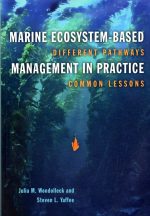
Reseña de libro en: Journal for Nature Conservation, 40 2017:
Julia M. Wondolleck & Steveb L. Yaffee
Marine ecosystem-based management in practice. Different pathways, common lessons.
Island Press, Washington DC, 270 pages, Price $35, ISBN 978-1-61091-799-5 (paperback)
Ver reseña
With such a title, one usually expects a book compiled of different papers and case studies presented at a symposium or congress; this one is different. During eight years, the authors have surveyed some sixty marine ecosystem-based managed (MEBM) projects in different countries, either successful or not, to end up with a selection of twelve cases, several ecological contexts, bottom-up and top-down initiatives, and all action levels, from the local to the international scale. Julia and Steven are professors of Natural Resources and Environmental Policy at the University of Michigan, and both have the experience of having previously undertaken a similar study –what works and what does not work in EBM-, but in the terrestrial realm. No wonder as the holistic approach to marine environmental affairs has, worldwide, experienced a marked delay of about twenty years in comparison with terrestrial affairs.
The authors claim to have found the common key elements supporting success in all these projects (and so far as one can deduce, it is not so different to their terrestrial counterparts). I like the metaphor they adopt to expose their findings: bricks and mortar. “The strength of a brick structure lies in both its bricks and its mortar. When the mortar decays, the structure crumbles regardless of how solid the bricks may seem, but too much mortar gluing together too little brick creates a very brittle structure”.
Bricks (Chapter 7) are the tangible factors: mandates, institutions, stakeholders, legislation, agreements, memoranda of understanding, data systems, formal fora, governance systems, a ‘table’ where you convene with interested people, funds, etc. Mortar (Chapter 8) represents the intangible factors, basically the skills and attitudes of people involved: commitment, sense of ownership, motivated engagement, friendly relationships, trust, credibility, patience, adaptability, etc.
Throughout chapters 2 to 6 several cases are dissected regarding all these factors: in the Gulf of Maine, Florida Keys and Channel Islands, Narragansett Bay and the Albermarle-Pamlico Estuary, Port Oxford (Oregon) and San Juan County (Washington), Puget Sound Georgia Basin, and the Gulf of Mexico. There are excellent examples about creating momentum, adapting to change, and sustaining progress in long-term projects (usually10-20 years). The narrative is fluid, enjoyable, and illuminating.
However, by reading these chapters one could perfectly change the title of the book to: ”Effective cooperation: case studies in the sea”, because all the discussion is related to the human factor and how to succeed in complex long-term cooperation. The proposals extracted and summarized in Chapter 9 (Implications for policy and practice) would be useful for any activity, anywhere. But what about the ecosystem based management? What does it mean and imply in the sea, apart from grouping many different kinds of partners?
The authors clearly state that science should drive management, and that credibility of any EBM initiative depends on that. Nonetheless, the “science part” is somewhat presented as a ‘given’ and very poorly treated. Okay, science without people goes nowhere, but people engaged in bad science are prone to enthusiastically produce rubbish. If you are at least partly interested in the scientific and technical aspects of EBM (how to set up ecologically relevant boundaries, key flux analysis, how to size resilience, compatibility matrices, etc.), this is not your book. I would suggest reading much smaller papers which deal with EBM in a less biased way. For instance, Ruckelshaus and collaborators´ Marine ecosystem-based management in practice: scientific and governance challenges, published in Bioscience in 2008.
In general, I miss some discussion referring to findings or proposals of other authors and institutions (UNESCO, WWF, IUCN, European Commission, FAO, etc.) which have produced interesting documents, including some that also contain case analysis in other continents and which also highlight the importance of the organizational part. This absence is especially intriguing, as Julia and Steven recommend that we not reinvent the wheel. Even so, I appreciate their mistrust towards available tool-boxes: “If my only tool is a hammer then all problems start to look like nails”.
The book is biased towards the human factor and the United States initiatives (almost all cases are from or involve this country). If cooperation for accessing common or disputed resources is a kind of behaviour that appeared late in the evolution of life, it seems that it is also a late achievement of cultural and institutional evolution. Perhaps the US Society is ahead of others in building bridges to link agencies, governments, communities, scientists, fishermen, businesses and organization with jurisdiction or concern for a marine ecosystem.
If you are already convinced that science is fundamental, but people with clear objectives are who really solve the problems through interaction between themselves and others, you can spare time by looking for other more concise literature related to marine EBM processes. However, if you are a science geek or somebody who expects people to automatically follow scientific conclusions then you will clearly benefit from reading this book.
A. Machado
Journal for Nature Conservation, Editor-in-Chief
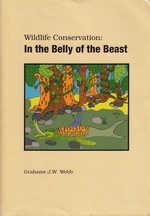
Reseña de libro en: Journal for Nature Conservation, 15 (1) 2015: 63.
Grahame J.W. Webb
Wildlife Conservation: In the Belly of the Beast
Charles Darwin University Press, 342 pages, 2014. ISBN 978-1-921576-88-1 (paperback). Price 59 – 80 €, available at: https://www.fga.net.au/wildlife-conservation-in-the-belly-of-the-beast-gr/w3/i1122256
Ver reseña
The combined titles of this book reflect perfectly its essence. It is not a technical handbook for wildlife conservation, nor is it an essay about the complexity of conservation calamities and challenges. It is the outpouring of many years of personal experience in this field, of deep analysis of how it operates, and of much critical reading. The end result is a gift of guidelines, tips, common sense and wisdom made available to the interested reader in wildlife conservation. Many of the ‘lessons’ provided are equally useful for other fields of conservation –like protected areas or ecological restoration– but the author limits it to familiar grounds. An admissible pity.
For those who are or wish to become professionals in wildlife conservation, Webb’s book is a must. It will spare them a lot of time, headaches, and prevent frustration. For the animal welfare people, ‘greenies’ and other passionate environmental activists it will surely be harder to read and digest. Nonetheless, I recommend that they dig in; at least for understanding why in many conservation conflicts the dedicated professionals or big-S scientist ‒in Webb’s terminology‒ are not joining them shoulder to shoulder, and very often are placed just in front. For politicians and media people, it will help clarifying the clues of the whole conservation game and their role within it. It may contribute to reorient attitudes, gain in efficiency, or to persist in hypocrisy in a conscious way.
The book has 45 chapters that could be read each on its own and in any order without losing their synergic power. They are grouped in seven sections: Discovery conservation; The role of knowledge; Riding the back of crocodiles; Wildlife conservation battlegrounds; Players and perceptions; Strategies and arenas; and Righting the wrongs. Section 3 on crocodiles is justified by Webb’s master experience and deep insight in conservation affairs of this group of herptiles, which build an exceptional example for understanding convergent problems in other groups. Of course, renowned flag-ship species are present in the section dedicated to battlegrounds: sea turtles, elephants, tigers, whales, etc.
To gain a better insight of the kind of content you will meet In the Belly of the Beast, here a set of keywords: Preservation, conservation, sustainable use, monitoring, species recovery, harvest, population thresholds, immigration, invasive species, extinctions, tenacious survivors, adaptive management, harvest, quotas, resilience, precautionary principle, IUCN red lists, black lists, invasive species… All these are common terms in conservation technique handbooks; but the set continues: conservation advocacy, inconvenient truths, moral outrage, manipulation, little-c scientist, ecoterror crimes, biased listing, international conferences, protectionism, CITES, wildlife trade, moratoria, conservation champions, Brigitte Bardot, bioethics, nature outsiders/insiders, aborigines, animal rights/welfare, bush foods, vegetarians, biopaternalism, biological bankruptcy, volunteers, NGO’s maintenance, biopolitics, spin, media, visual truth, legislative flaws, conservation myths, scientific masquerades, crying wolf, conservation business, greenwashing, Macquiavelo, perverse incentives, corruption…
Yes, conservation has as much to do with people and people’s affairs as dealing with lovely two-brown-eyed animals; especially, if you aim towards some positive results and not losing time, resources, and enthusiasm by working on the wrong target with the wrong people. The merit of the book is to place conservation in real life (= Realpolitik) and deal with all the actors, the scenario itself, and behind the scene (a brave approach, indeed). The only aspect I miss is more emphasis on the role of legislation in the overall drama and how fundamental it is to prevent the erosion of democracy in the name of conservation.
A bonus of the book is that it has been written by Grahame, as the writer that he is (novel Numunwari, 1980), in a sunny and fluent style, away from academic and technical corsets. Irony, soft humor, some local slang, and a trail of personal anecdotes are most welcome, as is the profusion of cutting cartoons peppering the whole book. Such an enjoyable approach does not harm the rigor and support of arguments, and the large list of references at the end justifies jumping to the last pages from time to time.
During the last World Conservation Congress, celebrated in Jeju in 2012, three main global problems were highlighted: other key sectors have to be involved, compromise and political will must increase, and more capacity building in nature management is needed. In this latter context, I hope that some engaged editor (IUCN?) translates this book into Spanish, Chinese and French. It would be a step forward in promoting wildlife conservation worldwide.
A. Machado
Journal for Nature Conservation, Editor-in-Chief
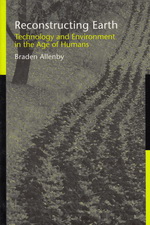
Reseña de libro : Journal for Nature Conservation, 14 (3-4) 2006, pp. 264-265.
Braden Allenby
Reconstructing Earth. Technology and environment in the age of humans
Island Press, Washington D.C., 2005. ISBN 1-59726-015-0 (paperback), 201 pages. $24.95. Contact: ejohnson@islandpress.org.
Ver reseña
This review is inserted in a special issue of the Journal for Nature Conservation devoted to Ecological Restoration, a concept itself that is not included in the index of Allenby’s new book. Perhaps this is not surprising, as Allenby is a professor of civil and environmental engineering and professor of law at Arizona Sate University, and author of Industrial Ecology (2002). Nonetheless, I selected Reconstructing Earth for this occasion as it provides us insight and raises up-front questions about the discourse of development in general, and about ecological restoration in particular. I avoided the use of the term “sustainable development”, termed by Allenby as a dangerous myth.
The book in my hand is not a technological manual nor a textbook for engineers. It is rather a critique to present environmentalism and a philosophical-ethical work, hence political in outreach, but does not lack conceptual framework for innovative approaches in the environmental area.
Reconstructing Earth is a compilation of 51 short essays first published in the Green Business Letter from 1988 to 2004. They are organised into 9 chapters, whose introductory text is a synthetic and systematized distillation of their basic content, much much appreciated by quick readers. Titles like “The commoditization of nature”, “Complexity: The New Frontier”, “Green Technology: From oxymoron to null set”, “The new environmentalist”, “Faith in Science”, “Toward a planetary ethic”, etc. give a flavour of the discourse presented. Much of it is not new under the umbrella of post-modern environmental philosophy, but the cornerstone is in accepting the reality, consequences, challenges, and opportunities of “The human Earth”, a by-product of the anthropocene, as he calls the present man-dominanted era.
Allenby calls for a new integrated approach to understanding and managing complex human/natural systems, what he calls ESEM (earth systems engineering and management). Such an approach should provide more lasting solutions to widespread environmental problems, or at the least for exploring new ways of looking into the future, instead of struggling with the fantasy of recovering pristine natural environments. ESEM is not highly elabotated, but some theoretical principles and underpinnings, principles for governance (a delicate issue!), and for design and engineering are given. It is something to be developed.
When writing about the anthropocene, the author should have recalled the Psychozoic era (the age of the mind), already coined by Le Conte in 1887, or more precisely, the concept of noösphere originated in the Bergsonian philosopher Ley Roy (Paris 1927), under the influence of Theilard de Chardin. A quote of Verndasky (1943), its champion, fits here: “The noösphere is a new geological phenomenon on our planet. In it for the first time man becomes a large-scale geological force. He can and must rebuild the province of his life by his work and thought, rebuild it radically in comparison with the past. Wider and wider creative possibilities open before him. It may be that the generation of our grandchildren will approach their blossoming”.
A sort of Earth guided by the intelligence of man is something too arrogant for many people. I personally prefer to term psychosphere the present mind-bearing biosphere, just as a simple fact descriptor. Our planet has been and is still run by bacteria, and it will be probably so in the future, whatever shaping or “dysfunctions” large metazoans ─like us─ may introduce. Allenby seems not to be so visionary or Marxist, but certainly he is very optimistic. At least, he is right in pointing forward towards the development of an interdisciplinary environmentalism void of nostalgia and grounded in realities, opportunities and man’s cultural assets. It’s a call to reason.
Another aspect of value in this book is the annotated bibliography that accompanies each chapter. The brief comments of Allenby to the selected titles make an interesting and rather useful guide to environmental reading, much appreciated in these times of publication overdose.
In conclusion, this is a reflexive book one can recommend not only to the environmental scientists, conservation biologists, industrial ecologists or anyone willing to engage in ecological restoration, but also to those concerned with the future of our species in this planet. As in Lomborg’s Skeptical Environmentalist, one may or may not like some of the approaches, but it is seminal reading and helps to put things in perspective.
A. Machado
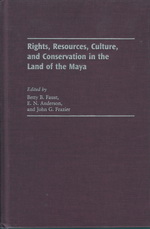
Reseña de libro : Journal for Nature Conservation, 14 (1) 2006, pp. 57-58.
Betty B. Faust, E.N.Anderson & John G. Frazier (Eds.)
Rights, resources, culture, and conservation in the land of the Maya
Praeger Publishers (Westport, CT, and Oxford) April 2004, 296 pages (Forward by June Nash. ); hardcover. ISBN : 0-89789-731-5. Price £ 46,99. Contact: www.greenwood.com,
Ver reseña
If we accept the premise that conservation of nature in a given territory is only feasible if interlinked with the local inhabitants needs, the present volume is a valuable contribution to helping understand the past and present complex relations of man’s affairs and nature in the Yucatan, a special part of Mexico. It is special not only from the biodiversity point of view, but also the archaeological and social. According to Mary Elmendorf, to whom this book is dedicated, the Mayan world still exists in the consciousness of the living heirs of classic Maya civilization. The traditional interconnected and cycled way of understanding life clashes with many generalised short minded and sectoral development/ conservation projects of present first to third world assistance. But not always. There are ways of searching for more sociological sustainable work that, on the other hand, turns out to be more ecologically sound. You can read about this in the several cases duly explained in this book.
It should be clear that this book is written as a wake up call to anthropologists (eleven contributions!) who have worked in the Yucatan for many years, with John G. Frazier, from the Smithsonian Institution, being the only guest conservation biologist invited. Yes, it is a book mainly written by anthropologists and, from my point of view, not always free from nostalgia or remnants of activism. However, any professional conservationist would find it good reading. The reasons why, could be the following:
First, the book gives a fantastic insight of Yucatan history, people and resources with a strong sense of place and time. And the Yucatan is a special part of our World where our species flourished for more of 3000 years in supposed equilibrium with nature; until now. Exogenous development (including conservation) models are easily unaware of complex long-termed based human-nature relations. For instance: religion, metaphors, and women, as in many other parts of traditional ‘biospheric’ societies, have a crucial influence in the management of essential natural resources.
Second: A global message emanates from the various case-studies presented: anthropologists have much to say in conservation issues. They are “trained in the identification, description, and evaluation of human social processes, political structures, social interactions, and cultural matrices, the sources of human motivation that illuminate the questions of why people do what they do” (including, with their environment). Elmendorf pioneered the participative research approach in the Yucatan, and the results of applying this methodology are evident in several chapters.
Third: John Frazier’s chapter is perhaps the most far-reaching one. It does not directly deal with typical conservation biology topics –his speciality– but rather the multi-relations of this discipline with the social sciences. Particularly remarkable is his review of relations of local NG0s with donors, government agencies and NGOs from the first world; all this happening in what he calls the postmodern, neoliberal, globalized world, or the Post-exuberant age. There is much wisdom in his chapter and the reflections it provokes are valid for any other region where external development /conservation assistance is engaged. Anti-globalization people will find it good.
According to Greenwood Publishing Group, the book will be of interest to cultural and biological anthropologists, development planners, international agencies and NGOs as well as readers concerned about the problems of integrating development, biodiversity, and traditional ways of life in rapidly changing rural and small town situations. I agree with this, but I hope that it would also be of interest to the inhabitants of the Yucatan peninsula, those heirs of Mayan culture in whose name and welfare the major part of the book is justified. So, I sincerely hope that this volume will be translated and published in Spanish. Otherwise, it would become one more case of the “Yucatan Syndrom”, as Frazier termed it. Ma t’aa, ku y u’ub a t’aan (= Yucatan) means We-Do-Not-Understand-what-You-Are-Saying, and it was supposedly the Mayan answer to the Spanish Conquistadores when they were asked about where they were living. Cultural imperialism is not always easy to overcome, and the first right of people –a preface to the right of freedom—is the right to be not saved.
In conclusion, I leave you with the table of contents: Introduction: A cultural history of technological change, resources management, population and environmental adaptation of Maya communities in the Yucatan, by E.N. Anderson and B. Faust.—Working with peoples and places through action, by Alicia Re Cruz.—The many worlds of Mayan woollen, by Mary Lindsay Elmendorf.—Shifts of strategies and focus of the conversion efforts of PRONATURA in the Yucatán, by Joann M. Andrews.—Population and land use, by Jenny Ericson.—Valuing the Maya forests, by E. N. Anderson.—The end of innocence in a modernizing Maya community, by Betty B. Faust.—Economic, political, and environmental changes in a Yucatec Maya village, by Grace Bascope.—The landscape of Santa Rita Komchen, by David W. Forrest.—The transformation of “paradise”: deep, social, and political ecology among the Yucatec Maya of Coba, Quintana Roo, Mexico, by Ellen R. Kintz and Amanda S. Ritchie.—Women’s human rights issues among the Maya, by Susannah Glusker.—The “Yucatan Syndrome”: its relevance to biological conservation and anthropological activities, by John G. Frazier.— Conclusions: Reflections on rights, resources, and responsibilities in participatory research, by Mary Lindsay Elmendorf.
A. Machado
Journal for Nature Conservation, Editor-in-Chief
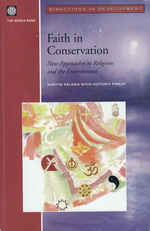
Reseña de libro : Journal for Nature Conservation, 12 (4) 2004, p. 251.
Martin Palmer & Victoria Finlay
Faith in conservation. New approaches to religions and the environment
The World Bank, Washington, D.C., 182 pages. August 2003. ISBN 0-8213-5559-7. Price: US$ 9. Email: dyoney@worldbank.org
Ver reseña
One could have doubts about including a reference to a book titled “Faith in conservation” in a scientific and technical journal like the JNC. The book has been published by the World Bank in the series “Directives of development”, and its title is perhaps a bit misleading. “Conservation through the world faiths” would probably be more accurate.
The Alliance of Religions and Conservation (ARC) consisting of eleven faiths, sponsored by the World Bank and with the support of the WWF and the BBC, have met to discuss and compile each of the faiths own statements summarising its relationship with and beliefs about the environment. This compilation of what the major world’s religions have to say about global development and its impact on the environment is an objective and valuable source of information not previously recorded elsewhere. It includes statements of Buddhism, Christianity, Hinduism, Islam, Juaism (the initial core of ARC) and of Baha’ism, Daoism, Jainism, Shintoism, Sikhism and Zoroastrism. Ideas are presented in their own way, including poetry, celebration, storytelling, myths or examples. Without a doubt, this document will become a prime reference-source for whoever is interested in involving people in applied conservation, in the field of environmental ethics or delving into the reasons why the natural resources of our planet are differently treated in different communities.
It is part two “The faith statements on Ecology”, in my view, the real value of the book. Martin Palmer and Victoria Finley wrote the first part, this first author being the main organiser of the ARC events that resulted in the unprecedented compilation just commented. Their text is of a different kind, with a subtle but permanent proselitism in favour of religions, despite their effort to sell a neutral position. The authors have over twenty years experience in working with the major faiths, and religious beliefs have proven in many cases to be a practical and efficient approach to gather results in the field of conservation. Palmer and Finley give several examples. However, this legitimate and useful approach is not a panacea and should not undermine other approaches, particularly that of science. Science is scored as an absolute together with socialism, marxism, capitalism, industrialisation, economics, fascism and so on. The message is: “forget this stuff, go for the faith”…
Scientific knowledge tries to be objective, compact and is always subject to verification. Revealed knowledge, on the contrary, cannot be challenged; the most it accepts are interpretations of the revealed truth. Because the ARC is the body working with the World Bank on environment and natural resources management from the faiths’ perspective, one could suspect if there is not an obscure interest on the part of the World Bank in shifting the debate of natural resource uses from the scientific arena.
The examples compiled in the first part and even the discourse of Palmer and Finally are of interest not only for persons with faith (incl. scientists), but for all kinds of practitioners in the field of conservation and resource management. One can learn how complex the world of morals and ethics is, and the hidden potentials it holds. Nonetheless, a cautious reading is recommended. For the second part, no fusspots. It is a unique source of information.
A. Machado
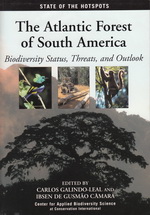
Reseña de libro : Journal for Nature Conservation, 12 (4) 2004, p. 252.
Carlos Galindo-Leal & Ibsen de Gusmâo Cãmara (eds.)
The Atlantic forest of South America. Biodiversity status, threats, and outlook
Island Press, Washington D.C., August 2003, 488 pp. Paper ISBN 1-55963-989-X ($ 35.00), Cloth ISBN 1-55963-988-1 ($ 70.00). Email: troeder@islandpress.org
Ver reseña
The Atlantic forest of South America is the first book in the “State of the hotspots” series from the Centre for Applied Biodiversity Science at Conservation International. One may recall Mittermeier & Myers’s “Hotspots” (1999) which claimed that twenty-five regions should contain 60% of the world’s animal and plant species in less than 2% of the earth’s surface.
A collection of 35 contributions by 59 experts from a variety of disciplines and countries presents a global overview of the situation and conservation diagnosis of the Atlantic Forest. Analysis and evaluations are carried out by country: Argentina, Brazil and Paraguay, each of which comprises a main chapter, with an additional chapter addressing trinational issues.
The analysis cover the current status and monitoring of biodiversity; the conservation priorities and important species; the socioeconomic drivers of deforestation; the existing policy initiatives and an evaluation of the capacity of local institutions to provide solutions and implement effective conservation actions.
The scope of the individual contributions varies considerably. Some may focus on flag species (i.e. the Golden Lion Tamarin), biodiversity loss in marine ecosystems (sic), causes of deforestation, evaluation of protected areas, aquifer services or fragmentation and landscape conservation. Nonetheless, this potpourri is more or less a repeated scheme for each of the three countries harbouring remnants of the Atlantic Forest.
The essence of this compilation effort can be found in the two first contributions (introduction) and in the conclusions termed “Outlooks for the Atlantic Forest”, where the editors of the book, Galindo-Leal and Cãmara reflect their global view and long term involvement with this issue. Contributions focused on the history of conservation also provides for revealing reading. It poses a base for meditation about the problems faced and real correction capacity of our society. Obviously, there is no better option than this book for anyone seeking for an updated view of the conservation situation in this important part of South America. This region suffers almost all kinds of conservation calamities: over-harvesting, perverse subsidies, industrial pollution, invasive aliens, landfills, slash and burn agriculture, destructive fishing, mistaken government policies, etc… Sometimes, it is a discouraging reading. However, the editors are almost freed from the environmental litany and look positively and courageously to the future. This is to be appreciated.
The book is well presented and I personally like the eclectic graphics that give the needed information, avoiding fancy image setting that other books fall into for commercial reasons. Once again, a credit for Island Press.
Perhaps the only point not resolved in the book is whether the number of species given as threatened with extinction reflects a real situation or is just a consequence of limited research. If new species are still being discovered, presumably extinct or quasi-extinct ones can be found more abundant or rediscovered once the needed prospective effort is undertaken. This is an unsolved question in many large and fragmented forest regions, and is hard to survey.
In conclusion, this book provides a good baseline knowledge for improving the informational and institutional capacity to support biodiversity conservation in the region. The goal of the Mata Atlantica Alliance is much closer now than before, as such collective efforts are built up. This first book of the “State of the hotspots” will surely have an impact on the negative trends from the past.
A. Machado
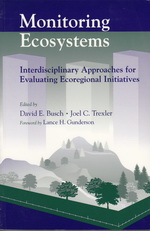
Reseña de libro : Journal for Nature Conservation, 11 (2) 2003, p. 130.
David E. Busch & Joel C. Trexler (editors)
Monitoring Ecosystems. Interdisciplinary approaches for evaluating ecoregional initiatives
Island Press, Washington DC, 2003, 447 pp. ISBN 1-55963-850-8. Paper $35.00, Hardback $70.00.
Ver reseña
Monitoring is a must in many undertakings. Since the early 60s, when it emerged as a defined activity in environmental and conservation matters, it has evolved to different objectives, scales and contexts, thus gaining accuracy and effectiveness. The times of monitoring for its own sake are over. At present, monitoring is management oriented, and Lance H. Gunderson is right when he states in the Preface, while linking monitoring with adaptive management: “Adaptive management was developed as an antithesis to resource management approaches in which ecosystems were considered predictable, where impacts could be determined a prioiri, and where management consisted of ‘command and control’ attitudes toward nature. …… monitoring provides the basis for learning and understanding in an unpredictable world.”
This new Island Press book covers a particular field: monitoring of ecosystems at a regional scale. It originated at a symposium of the Ecological Society of America entitled “Interdisciplinary approach to ecological monitoring of major ecosystem restoration initiatives” (Skokane, Wash. 1999). Such a scope implies much complexity; rather more than simple monitoring of pollutants, target species populations or the like.
All authors are from the United States. Thirteen contributions are grouped under three related sections: (2) Principles of ecosystem monitoring design, (3) Information management and modelling for monitoring programs, and (4) Monitoring habitats, populations and communities. In addition, an (1) Introduction and an ending (5) Summary and synthesis chapters are also provided by the editors. The latter gives a rather superficial overview which does not replace the need for reading the individual chapters where much of the practical usefulness of the book is to be found: types of indicators that can be considered for monitoring biodiversity (by Gaines), integration of remotely sensed and plotted based data (by Hemstrom), estimating population change from monitoring survey data (by Sauer et al.), a scientific approach to develop strategies for regional ecosystem monitoring (by Odgen et al.) etc. Of particular relevance to me is chapter 2 by Barry R. Noon: “Conceptual issues in monitoring ecological resources” which provides a much needed theoretical underpinning for ecological monitoring on a large scale. Previous regional (country or continental) initiatives have traditionally concentrated on monitoring pollutants or specific taxa; but less in ecosystems as a whole. Altogether, the book offers a comprehensive view of the complexity involved in adaptive management of natural resources and ecological monitoring at regional scales. At the same time, it provides a solid conceptual framework for students and practitioners in this emerging discipline.
The only drawback I perceive is its relatively restricted applicability outside the United States, Canada or a few countries with mature natural resources Administrations and a long tradition of inter-institutional cooperation. The idea of studying eco-regions and adaptively managing the resources within is a wise approach emerging during the last decade in the US. But, as said, few countries have at present the conditions necessary to conduct the effort and develop institutional coordinative frameworks similar to those presented for the South Florida Everglades, the Northwest Forest Plan or the Lower Colorado River initiative. Nonetheless, the message is forwarded; the path indicated, and many practical procedures to develop strategies and to design and carry out good monitoring are given. It is not utopian.
Even if you are not involved in designing or implementing an ecosystem monitoring program at regional scale, you will certainly benefit from reading this book or some chapters. It may not focus on your particular case, but the rationale of monitoring is there and enough experience condensed in the set of contributions so as to provide you with some intelligent guidelines of how or how not to proceed. There are perhaps no other titles in this field with such a blend of theory and gained experience at the eco-regional scale. At least for the United States, it is a cornerstone to build on.
A. Machado
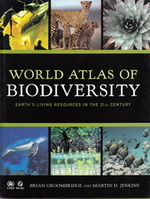
Reseña de libro : Journal for Nature Conservation, 11 (2) 2003: 129-130.
Brian Groombridge & Martin D. Jenkins
World atlas of biodiversity. Earth’s living resources in the 21st century
Prepared by the UNEP World Conservation Monitoring Centre. University of California Press, Berkeley (USA), 2002. 256 pages, 8-1/2 x 11”, 37 maps, 25 figures. 49 tables, 33 colour photographs. ISBN 0-520-23668-8 (cloth edition). $54,95. https://www.ucpress.edu/books/pages/pp41.html
Ver reseña
This new book of Brian Groombridge and Martin D. Jenkins is presented as the first map-based view of the world’s living resources with the latest research and findings in an accessible volume. Either the natural resources of our planet have been depleted to such an extent as to fit in one volume, or the authors have achieved an outstanding work of synthesis. Thanks to the support of the World Conservation Monitoring Centre, the latter is the case. There is also a long list of additional contributors, many NGOs and research agencies that help explain the accuracy of many specific items within the book. One has the feeling of facing the emergent part of a huge iceberg of information.
The book is structured in four thematic sections.: The introductory one is devoted to the scenario (biosphere) and the actors (species): Global cycles of materials, energy flow and the role of biodiversity is authoritatively presented. However, the outstanding relevance of micro organisms in the global functioning of the biosphere as shown is not reflected accordingly in the following chapters (a common macropod view’s bias in this kind of books). The diversity of organisms is synoptically exposed and complemented in Annex 1 with ca 100 short group descriptions, but the authors did not made a good choice by following Margulis’ “Five Kingdoms”. Protoctista are known to be an inconvenient hotchpotch and recent works, for instance “The variety of Life” of Colin Tudge (2000), give a more updated and phylogentic view of present and past life forms. The historical perspective of biodiversity given in chapter 3 is important, putting the present extinction crisis in the right context. Extinction means new chances for the surviving groups.
The second section (chapter 4) deals with relationships between humanity and biodiversity, covering the increasing use of biotic resources (nutrition, fibres, etc.) and the consequences of our civilization’s pressure on the environment and species. Antropogenic biodiversity is properly covered in this long chapter, which is qualified by abundant maps, tables and ad-hoc boxes. Tendencies in species extinction (and causes of extinction) are presented realistically, without inflation. I particularly like the concept of Lazarus species, for those that were presumed extinct and have been rediscovered.
Section three (chapters 5, 6 and 7) gives an overview of biodiversity and its trends in the three major biomes: terrestrial, marine and inland waters. Again, these are chapters where maps are highly informative as well as tables and graphs. To highlight, the references to the WWF living planet index regarding different resources.
Looking at the distribution maps, it is clear that life concentrates in the tropics, biodiversity in the northern latitudes being a rather simplified version of “life” and community structure. After so many years of Eurocentric and first-world perspectives, one must wonder about the ideas and conceptions of an ecologist born and trained in the tropics. And a microbiologist would surely also bring new insights to the so-called present biosphere “crisis”. Something to consider for the next edition.
Chapter 8 closes the work by exposing the reaction and responses of man aiming to maintain ecosystem health (I would better call it integrity or naturalness) and the search for more sustainable approaches to material development. This chapter is very authoritative and well balanced, emphasizing major actions undertaken on a global scale, including scenario evaluations (RIVM Image), GLOBIO methodological approach and other recent studies. Obviously, the international dimension is prioritized in the text and, maybe, is not fully free of a certain kind of naivety, as is usual in international fora. However, the authors’ position cannot be classified either as optimistic, pessimistic or proselytising, but showing rather a sort of neutral “scientific” approach, certain to be most appreciated.
In any case, the text is superb, well interconnected and coherently woven, far from the cut-and-paste strategies of other authors in similar works. Pictures that garnish the book have been used to a prudent extent and size so as to not divert attention from the main text, which is its core value. Appendices (one third of the pages) cover the phyla of living organisms, important food crops, domestic livestock, recent vertebrate extinction, biodiversity at country level and important areas for freshwater biodiversity.
The book should appeal to many people, from the concerned citizen, to academics, conservation practitioners, policymakers and politicians. Its publication (September 2, 2002) was scheduled to coincide with the World Summit on Sustainable Development held in Johannesburg). Amongst the growing avalanche of titles referring to biodiversity, I would not hesitate to recommend the present one as perhaps the most concise and balanced option to gain an overview of the current state of global biodiversity. And as already said, in one single and handy volume.
A. Machado
Journal for Nature Conservation, Editor-in-Chief
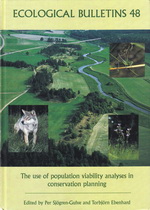
Reseña de libro: Journal for Nature Conservation, 15 (1) 2015: 63.
Per Sjögren-Gulve & Torbjörn Ebenhard (eds.)
The use of population viability analyses in conservation planning
Ecological Bulletins 48, (2000), 205 pp. Published and distributed by Munksgaard International Publishers Ltd. (Denmark). DKK 300.00 (hardback), ISBN 87-16-16382-6.
Ver reseña
This issue of the Ecological Bulletins presents a selection of papers from a two-day symposium of the same title, organised at Stockholm (December 1997) by the Swedish Environmental Protection Agency (SEPA) and the Swedish Biodiversity Centre. Conservation management is an increasing demand in today’s modern society as we aim towards a more sustainable development . Trial and error approaches are abundant, real useful tools extremely scarce, and aggregated theory even more rare. Thus, any attempt to review and consolidate practice and theory is to be welcomed.
In the last decade, population viability analysis (PVAs) –including risk assessment models– have been widely used to guide threatened species management and assess extinction risks. The overview presented by Akçaya & Sjögren-Gulve in the first chapter, gives due account of the range and methodological models existing in this emerging field, as well as the disadvantages of its quantitative approach and the single-species focus involved. This well balanced “introduction” is obligatory reading, I would say.
The main body of the book is formed firstly by a set of contributions of academic conservation biologists, and secondly by a set of study-cases written by real-life managers, concluding with a paper by U. Gärdenfors on the use of PVA in the classification of threatened species and a presentation by R. C. Lacy of the structure, logics and reach of VORTEX, a demographic and genetic PVA computer simulation model, which is becoming rather popular among conservation managers.
The book covers, albeit not uniformly in-depth, almost all the present PVA debate. H.R. Akçakaya discusses demographically and spatially age- or stage-structured models; R. C. Lacy uses individual-based models to assess threats of small populations, and Sjögren-Gulve & Hanski explain thoroughly the analysis of metapopulation viability by using occupancy models, with an additional paper of Menge along this same line but focused on the particularities of plant species. It is needless to say that the spatial dimension has been traditionally the tricky part of demographic models. Furthermore, Fleishman et al. screen focal taxa for conservation planning by nested subset analyses in order to link them with larger groups of similar habitat requirements, so they can be subjected to PVAs (‘umbrella’ species?). Their method is illustrated with examples of cryptograms from the Swedish boreal forest and mountain butterfly in the western United States. At the end, however, it seems clear to the reader, that species group, habitat type and obtainibility of data always play a decisive role when selecting the most appropriate model.
The more illustrative section of the book starts with a paper of O. Kinvall in which local extinctions and colonization in a bush-cricket metapopulation is predicted following several demographic models compared versus more simpler occupancy models. The other four case studies are specific applications of the basic models previously discussed and include: a management experiment with a pasture plant (T. Lennartsson), the case of a relict sand lizard threatened population (S.-D Berglind), the case of the wolf, otter and peregrine falcon (T. Ebenhard) and the case of the tree frog in the Netherlands (C.C. Vos et al.) All the other studies have been developed in Sweden.
The book should appeal especially to researchers, students and conservation practitioners who also can find several other recent books that attempt to provide a comprehensive, updated and critical exposition of PVA theory more or less condimented by case studies. Overall the present book is a good and advisable choice, though at times patchy and slightly biased towards European scenarios. It is tidily produced, richly illustrated, well referenced and with an abundance of sharply exposed examples. If you work in conservation, this is a book to keep in your personal cabinet. However, the perennial dilemma of how much time you need to feed PVA models with data and how long you can reasonably delay a decision, will still be the unavoidable Damocle’s sword hanging over your management responsibility.
A. Machado
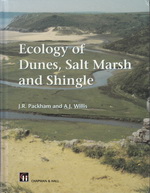
Reseña de libro : Journal for Nature Conservation, 10 (1) 2001 p. 64.
J. R. Packham & Arthur J. Willis
Ecology of dunes, salt marsh and shingle
Chapman & Hall, London, 1997. 335 pp. € 109.50 (hardbound). ISBN 0-412-57980-4
Ver reseña
Coastal environments have always attracted the attention of ecologists, with particular emphasis on halophytic systems and sand dunes, which pose, obviously, a particular stress to all their inhabitants. Ecology of salt marshes and sand dunes (Ranwell, 1972) and Saltmarsh Ecology (Adam, 1990) are classic reading in this area. However, the present book of Packham & Willis is more comprehensive. Its approach is truly holistic, centred on processes and, thus, facilitating a full understanding of these complex and very dynamic systems. Geomorphological development of salt marshes, shingle structures and dunes are linked to community dynamics and well documented with examples from different parts of the world, although, most temperate regions (British Isles, continental Europe and North America). Primary and secondary production; their limiting factors, energy flows and nutrient cycling are basic aspects of ecology not always properly covered in other more descriptive books; but not here. On the other hand, eco-physiological aspects due to the high ionic content of water, or morphological adaptive syndromes to live between the grains are also extensively treated with well-chosen examples. In general, there is little or almost no theoretical speculation and much precise, reliable and succinct ecological information.
Traditionally obscure aspects like coastal microbial ecology and their role in nitrogen fixation have a section that could be enlarged in future editions, like some concepts dealt with in the concise introductionary chapter. The three last chapters focus on man-related problems: environmental impacts, variation in sea level linked to climatic change, and coastal management and conservation. However, the purpose of this book is not to deal in depth with conservational aspects; if they are present is for it completing the global view of these particular coastal environments. For coastal conservation and management there is the companion book of J. Pat Doody which is the reason why we are presenting both together in this review. Nonetheless, the present book is the sort of fundamental reading one needs if confronting any conservation problems It will give the technician or student enough background knowledge of coastal ecology to feel confident, and is also ideal for advanced training courses. The wide-ranging bibliography is also an outstanding merit of this book.
A. Machado
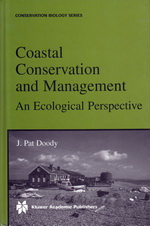
Reseña de libro : Journal for Nature Conservation 10(1) 2001: p. 64.
J. Pat. Doody
Coastal conservation and management. An ecological perspective
Conservation Biology Series, 13. 2000 (F.B. Goldsmith, F.B. & E. Duffey, eds.), Kluwer Academic Publishers, Dordrecht, 308 pp.
€ 147.50 (hardbound). ISBN 0-412-59470-6. Distribution: services@wkap.nl
Ver reseña
This book and that of Packham and Willis above reviewed, complement each other. The former focuses scientifically on coastal ecology, while the present one concentrates on conservation and management with almost no ecological theoretical support. Its range is a bit wider; in addition to salt marsh, shingle and sandy systems, it incorporates coastal cliffs, mixed systems like estuaries and coastal wetlands, as well as areas claimed from the sea such as coastal grazing marshes. One of its merits is the inclusion of all these coastal environments (subtidal excluded), their management challenges and accumulated knowledge in a comprehensive way. Most of the content relates to Doody’s 20 years of experience in this matter, but without ostracising other authors’ positioning (ample references). He also handles the international and European context of coastal conservation (conventions, directives), particularly the move towards ecological networks and integrated coastal managements.
Nonetheless, this book has a rather “personal” stamp, as the author belongs to the latest crop of conservationists; those who deal with nature with a more professional attitude and less passionate and biophylic eyes. Man is recognised as a key element in the historical shaping of coastal environments, at least in the temperate regions of the northern hemisphere which is the scope of the book. Man is not demonised; on the contrary, he is the way out for most of the conservation problems. The so-called new approach—“Win some, lose some” isn’t so new if one considers consensus-oriented techniques long ago promoted by conservation policy in the author’s own country or in the United States. More outstanding is his recognition of gemorphological processes in the coastal ecosystems as having a major an more flexible role to play in responding to changes such as the rise of sea levels expected from global warming. Coastal systems seem to be more robust than normally accepted, and they have survived despite the “coastal squeeze” and intensive human use. This would surety make good arguing for “the skeptical environmentalist” of Bjørn Lomborg (2001).
This book includes the major coastal habitats of nature conservation interest and their management. It is convenient reading for anyone involved in this field of activity. However, we would suggest to first study Packham & Willis companion text in order to gain the proper ecological perspective for a critical and self-sustained appraisal of this one.
Antonio Machado
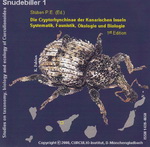
Revisión en Elytron 14, 2001: pp. 213-214.
Stüben, P.E. (Editor)
Die Cryptorhynchinae der Kanarischen Inseln. Systematik, Faunistik, Ökologie und Biologie
Snudebiller 1, 2000 (CD-Rom), 910 fotos a color, 266 fotos microscopio de barrido, 118 mapas de repartición, 18 registros sonoros y 1 video; 413 páginas (670 MB). CURCULIO-Institut, Hauweg 62, D-41066 Mönchengladbach, Alemania.
Ver reseña
Aprovechando las nuevas tecnologías para la edición aceptadas por el Código Internacional de Nomenclatura Zoológica a partir del año 2000, ha aparecido el primer volumen en CD de Snudebiller, dedicado a los coleópteros curculiónidos de la subfamilia Cryptorhychinae de las islas Canarias. Comprende el volumen un total de 16 trabajos que, en su conjunto, ofrecen una visión actualizada y completa de este grupo en el archipiélago canario, incluido un artículo de L. Sánchez Pinto bien documentado e ilustrado sobre la historia de los bosques de laurisilva en Canarias, hábitat esencial tanto para estos curculiónidos como para gran cantidad de insectos endémicos de las islas.
La Introducción –a cargo de P.E. Stüben– incorpora un ameno e ilustrado relato histórico sobre los estudios de Cryptorhynchinae en Canarias, además de información pormenorizada sobre métodos de trabajo de campo –algunos novedosos– y laboratorio, colecciones estudiadas, colaboradores, etc. El grupo de estudios “Acalles” del Curculio Institut (Mönchengladbach, Alemania) ha dedicado 3 años (1997-1999) a estudiar este grupo en Canarias, visitando las islas en numerosas ocasiones y recogiendo un total de 6.160 ejemplares, además de otros 3.429 procedentes de colecciones privadas e institucionales, que también han sido incorporados al presente trabajo.
El cuerpo principal del volumen lo componen 8 contribuciones destinadas a la revisión sistemática del grupo. Con la salvedad del artículo de F. Bahr dedicado al género Calacalles en el paleártico occidental, todas los demás están a cargo de P.E. Stüben, tratando separadamente las claves generales y cada uno de los géneros: Acalles, Dichromacalles, Onyxacalles, Echinodera, Torneuma y Paratorneuma. Además de la correspondiente designación de lectotipos, establecimiento de sinonimias, etc., se describe un total de 26 especies nuevas (14 Acalles, 7 Calacalles y 5 Echinodera), con profusión de detalles morfológicos ilustrados en fotografía convencional y al microscopio electrónico de barrido. Algunas de estas especies solo son discernibles comparando la estructura del saco interno del edeago. Las claves de determinación –al igual que el trabajo sobre la historia de la laurisilva– están traducidas al español. Cierra la sección un trabajo de Ch. Bayer y P.E. Stüben sobre 6 larvas de Acalles y 1 de Onyxacalles, estrableciendo las diferencias entre estos géneros y Dichromacalles.
Conforman una tercera sección un artículo de L. Behne sobre faunística (con los datos de 9.589 ejemplares procedentes de 508 localidades) y otros dos de P.E. Stüben sobre filogenia de los Acalles endémicos y acerca de la biogeografía y evolución de los Cryptorhynchinae de Canarias.
La última sección contiene un interesante trabajo de Klaus Riede y Peter E. Stüben sobre los Acalles “musicales”, donde además de estudiar los órganos de estridulación, se pueden ver y oír los sonogramas de 12 especies (inc. Onyxacalles y Dichromacalles). Evidentemente, ésta es una interesante opción abierta por las nuevas tecnologías de edición. También se incluye un extenso artículo de Peter Sprick y P.E. Stüben sobre la ecología de los Cryptorhynchinae que viven fuera de la laurisilva, tanto en ambientes ruderales como en las formaciones de Euphorbia y las comunidades rupícolas ricas en plantas crasas (Aeonium, etc.). Un detallado trabajo basado en abundante y novedosa información de campo, que plantea interesantes hipótesis de adaptación y evolución radiativa intrainsular. También aquí se agradece la abundancia de ilustraciones que acompañan al artículo: plantas alimenticias, hábitats, mapas de distribución, esquemas de distribución altitudinal, etc.
La obra está realizada con el rigor que requiere toda revisión sistemática, pudiendo considerarse asimismo una revisión faunística, dado el detalle de prospección alcanzado. Los trabajos dedicados a las larvas, estridulación, hábitats, etc., permiten completar la visión general de este grupo en el territorio, de modo que el análisis faunístico, biogeográfico y evolutivo que realiza el autor principal adquiere bastante consistencia, no pudiendo planteársele otro inconveniente que el de no haber intentado cotejar sus hipótesis filogenéticas a través del análisis del DNA.
En resumen, una obra completa y moderna que ofrece una visión actualizada y en contexto territorial de un grupo de coleópteros de Canarias muy rico en endemismos, y en la que quedan de manifiesto muchas de las ventajas que ofrece publicar en soporte electrónico (sonido, video, profusión de imágenes fotográficas, búsqueda independiente de figuras por especies, …(y precio).
Antonio Machado Carrillo & Pedro Oromí Masoliver
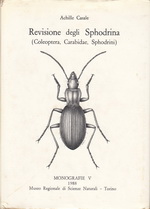
Reseña de libro en: Vieraea 18 (3-4) 1990 p 384.
Casale, A.
Revisione degli Sphodrina (Coleoptera, Carabidae, Sphodrini)
Torino: Museo Regionale di Scienze Naturali, Monographie V, 1024 pp.. 1401 figs.
Ver reseña
La presente obra de Achile Casale, carabidólogo de consumada trayectoria, es una «revisión de grupo» en su sentido estricto, y corresponde a los «Sphodrina», auténticos Sphodrini, que son redefinidos en la sistemática de los Pterostichinae y presentados como grupo monofilético, adelfo-taxon de los Platynini * Geobaenini * Enoicini.
EI voluminoso trabajo dedica en su primer capítulo una moderada extensión a la morfología imaginal y preimaginal, tratando las series evolutivas de los caracteres más significativos, sin eludir el análisis crítico de las hipótesis de otros autores. Incluye asimismo un capítulo sobre bionomía que reúne una documentada síntesis sobre Ia ecología de estos Pterostiquidos (factores bióticos, abióticos, «habitats choice», etc.), donde la experiencia personal del autor se hace sentir. La radiación adaptativa a los ambientes hipogeos planteada resulta particularmente atractiva.
En el inicio de la parte sistemática, es donde el autor toma una postura de compromiso importante. En su análisis crítico de los caracteres, defiende unos esquemas filogenéticos expresados en dendrogramas de «afinidad hipotética», que no siempre se sabe a qué series de transformación de las presentadas hacen referencia, si realmente se tratan de cladogramas, o si son filogramas más o menos empíricos. El filograma de la fig. 132 parece ser el más sustentado cladísticamente y de hecho se hace referencia a algunos caracteres, pero tiene problemas con grupos como Atranopsina, donde se incluyen numerosos géneros endémicos de Canarias (Amaroschema no encaja) y con la línea filética de Licinopsis, en los Sphodrina, también particular de Canarias.
Los caracteres de estos géneros canarios que habitualmente se consideraban como primitivos son presentados por Casale como derivados y ofrece argumentos que en algunos casos podrían aceptarse (pubescencia del 3er antenómero, de los tarsos, etc) aunque en otros como el relativo a los puntos setígeros de los éIitros, el propio Casale admite la dificultad de aceptar tal versión. EI problema no queda resuelto con el simple hecho de señalarlo.
Los géneros (13 en total) y las 269 especies son tratadas por Casale con su habitual maestría, cubriendo las sinonimias, descripción, discusión y corologla, esta última bastante actualizada. Destaca la abundante y precisa iconografía (1401 figuras) que en la mayoría de los casos incluye a 1os imaqos. En general la obra incluye la descripción de 3 géneros y 4 subgéneros nuevos, 36 especies y 12 subespecies nuevas y numerosísimas sinonimizaciones o confirmaciones de especies.
La parle V está dedicada a la biogeografía y en ella el autor desarrolla en detalle un esquema biogeográfico del grupo que, evidentemente, entronca con el esquema filogenético expuesto en la parte anterior. Así, por ejemplo, la línea filética de Sphodrus es presentada como la más plesiomórfica y primitiva, y no la de Licinopsis como alternativamente se podría argumentar. Exceptuando tal vez este último grupo que, como todos los Pterostiquidos canarios, plantea serios problemas de interpretación, el esquema restante es concreto y consolidado.
Concluye la obra una extensa y exhaustiva bibliografía con 487 referencias.
La monografia de Casale es un trabajo de ejecución primorosa y exhaustiva, modélico en la revisión taxonómica de especies. Tal vez la única crítica factible a un proyecto de este tipo y envergadura es la ausencia de un análisis cladístico formal para sustentar el esquema filogenético del Sistema adoptado. Pero esto es cuestión de escuelas y no afecta sustancialmente a la validez taxonómica de la obra. Su consulta es ineludible para cualquier Carabidólogo que se ocupe de los Pterostíquidos y, evidentemente, de los Sphodrina. La parte sistemática e hipotética será de seguro, fuente de futuros trabajos y discusión; y esto es bueno y necesario en la Ciencia.
Antonio Machado Carrillo
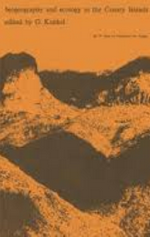
Reseña de libro en: Vieraea 6 (1) 1976 p 165.
G. Kunkel (ed.)
Biogeography and Ecology in the Canary Islands
Monographia Biologicae 30. Dr. W. Junk b.v. Publishers, The Hague 1976, 511 pp. Precio 160 florines holandeses.
Ver reseña
Esta es una importante obra sobre Canarias, aparecida recientemente en La Haya y publicada con profusión de fotos y grabados por la prestigiosa casa «Dr. W. Junk b. v. Publishers». Corresponde al volumen 30 de una serie, «Monographia Biologicae», que con editor al Dr. J. Illies, viene tratando diversas regiones del mundo: Tasmania, Nueva Zelanda, Madagascar, Sudamérica, etc.
Kunkel ha sabido aglutinar en este libro los trabajos de distintos autores intentando dar una visión más o menos amplia de Canarias. No es un libro completo, pues las Islas Canarias no caben siquiera en una biblioteca, pero sí es un libro interesante. Algunos aspectos de nuestra Naturaleza no han sido tratados, sobre todo los zoológicos. No obstante ofrece una visión aproximada de conjunto bastante moderna y a falta de otras, sea bien recibida. Algunos trabajos son recopilaciones sobre el tema, otros son originales, lo que puede resultar algo parcial, pero de una u otra forma, se establece como una obra por la que se ha de pasar en futuras investigaciones. Por más, las extensas relaciones bibliográficas que acompañan a cada capítulo, son de un alto valor práctico.
El libro, como es usual en esta serie, se ha publicado en inglés, salvo un trabajo, el XIV, que viene en castellano. A continuación resumimos su contenido (traducido):
I. G. KUNKEL. Introducción (14 pp.).- II. I. SCHWIDETZKY. La población prehispánica de las islas Canarias (22 pp.).- III. J. KRüSS. Los nombres de las Islas Canarias y su verificación (29 pp.).– IV. H.U. SCMINCKE. Geología de las islas Canarias (118 pp.).- V. D. FERNANDOPULLE. Características climáticas de las islas Canarias (22 pp.).- VI. D. BRAMWELL. La flora endémica de las islas Canarias (34 pp.).- VII. E. SCHMID. La laurisilva del Hierro (B pp.).- VIII. G. KUNKEL. Notas sobre elementos introducidos en la flora de las islas Canarias (18 pp.).- IX. G. FOLLMAN, Flora y vegetación liquenológica de las islas Canarias (20 pp.).- X. H.B. GJAERUM. Panorama de la flora fúngica de las islas Canarias (10 pp.).- XI. A. GONZÁLEZ. Productos naturales extraídos de las plantas de las islas Canarias (29 pp.).- XII. F. KRAMMER. La influencia del hombre en la vegetación de la isla de El Hierro (20 pp.).- XIII. A. MACHADO. Introducción a un estudio faunístico de la Laurisilva de las islas Canarias, con especial referencia a los carábidos (65 pp.).-XIV. J.J. BACALLADO. Notas sobre la distribución y evolución de la avifauna canaria (19 pp.).- XV. K. KLEMMER. Anfibios y reptiles de las islas Canarias (20 pp.).- XVI. P. RÖBEN. Recuento de la fauna: limnológica de las islas Canarias (22 pp.).- XVII. M. SUTTON. Conservación de ecosistemas frágiles en las islas Canarias.
Es de lamentar que el libro no disponga de pequeños resúmenes en español ya que es la lengua que se habla en la región que ha sido objeto de estudio.
A. Machado

